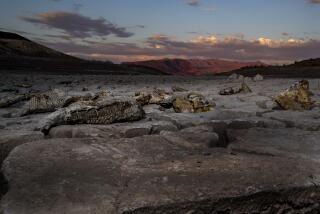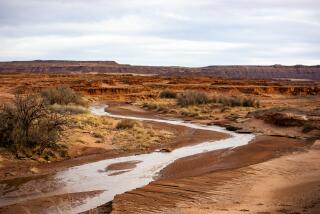Book review: ‘Elixir: A History of Water and Humankind’
It’s a typically Western irony that a well-researched and thoughtful book about water and its scarcity would be published during a spring that left every river from the Mississippi to the Colorado brimming, and water managers facing the unusual task of optimizing nature’s largess.
But Mark Twain had it right when he said climate is what you expect; weather is what you get. The West largely got strange weather this year. In its climatic history, the bulk of the West beyond the 100th meridian is constrained by aridity.
Into this volatile mix wades Brian Fagan, an anthropologist and archaeologist, with “Elixir: A History of Water and Humankind,” a work that juxtaposes ancient and contemporary cultures’ veneration of water with the current commodification of it, and finds the latter morally lacking and potentially self-destructive.
“We live in an industrial age of water as a commodity, yet alongside us thrive much smaller societies that use water wisely, as they always have,” writes Fagan. “History teaches us that the societies that last longest are those that treat water with respect, as an elixir of life, a gift from the gods. We seem to have forgotten this compelling lesson.”
Fagan offers ample evidence that water has been managed respectfully and peacefully at local levels, without centralized water boards or heavy-handed governments — the Berbers did it before the Romans; the ancient Greeks, from whom the Romans borrowed, largely managed water through cooperation and self-regulation; and the Hohokam in the present-day Southwest apparently did so without “great leaders who supervised water harvesting, canal construction or allocation of water to the fields.”
Fagan is taking a position against the mainstream, which holds that the need for massive waterworks created “hydraulic powers” that were highly centralized and often despotic. Such was the underlying theme of Steven Solomon’s “Water: The Epic Struggle for Wealth, Power and Civilization,” which was released earlier this year in trade paperback.
Rather than drive his counterpoint home, however, Fagan ultimately circles about in the manner of a long series of lectures that exhaustively catalog hydrological developments from qanats to norias, yet never develop the sweeping narrative promised in the title. “Elixir” is a sprawling survey of hydrology through time, not really “a history of water and humankind.”
Fagan’s thesis of divorcing the control of water from the rise of empire ultimately amounts to academic quibbling that gets in the way of explaining the Romans and ancient Chinese, both of whom achieved hydrologic wonders through despotic central rule and conscripted labor. It’s also a safe argument that only a strong executive branch during an economic Depression could have built the Hoover Dam — largely on the back of compliant labor in a company town under the thumb of monopolistic contracting companies. (See: Michael Hiltzik’s book “Colossus: The Turbulent, Thrilling Saga of the Building of Hoover Dam.”)
When Fagan finally lands on Phoenix as the poster child of sprawl versus scarcity, he acknowledges the role of a hydraulic power imposing its will: “All prudent estimates suggest that it is not too late to discourage through taxation and other types of pricing the growth of populations on the urban periphery who will be most vulnerable to water shortages.” Republican Phoenix must impose a tax or its water agencies must hike their prices, in other words.
Fagan is a passionate and lively writer who has enjoyed breakout success from the shelves of academia with “The Great Warming,” about the tumultuous medieval period of climate change in Europe. The work rode atop a hot current topic and was written for the layman, with numerous fictional verbal dioramas that made that world’s detail come to life.
In “Elixir,” these vignettes get in the way of what ultimately is an academic book. The broad facts underlying such verbal flights are supported by the archaeological record, but Fagan waxes too fanciful. For example: There was a catastrophic flood on China’s Huang River in the second or third century of the Common Era. But there is no way to substantiate this: “A man points to a high river levee some distance away. A violent flood from rainfall far upstream had breached the earthen bank. Yellow-brown floodwater cascades through a widening gap in the embankment with a dull roar.”
Fagan’s explanation of how water-seeking desert dwellers abandoned horizontal tunneling into alluvial fans in favor of safer vertical tunnels called qanats works well enough without a saccharine tale. “One can imagine two boys tunneling into sand and loose gravel,” Fagan writes. “Water percolates alongside their sweating bodies, as their father offers encouragement from outside. Suddenly, the ceiling collapses in a torrent of gravel and groundwater that buries the diggers in an instant. The father darts forward, grabs each boy by the ankles, and drags them clear.”
Those who approach this book from academia will rightfully shudder. But those who approach from the unschooled masses cannot be sustained this time by these passages. For them, “Elixir” may come up dry.
Mohan edits The Times’ environmental coverage.
More to Read
Sign up for our Book Club newsletter
Get the latest news, events and more from the Los Angeles Times Book Club, and help us get L.A. reading and talking.
You may occasionally receive promotional content from the Los Angeles Times.









